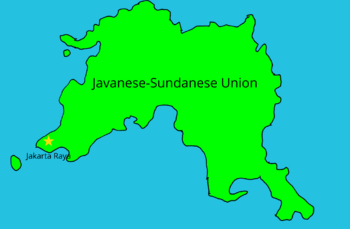Javanese-Sundanese Union
Jawa-Sunda Federal Republic Javanese-Sundanese Union | |
|---|---|
|
Flag | |
| Motto: Bekerja Untuk Majikan Work for employer | |
| Anthem: Bersatulah! | |
 Javanese Sundanese Map | |
| Location | Javanese Sundanese Map |
| Jawa-Sunda | Jawa-Sunda |
| Leaders | |
• President | Teguh Sutratman |
| Establishment | Formation |
• Javanese and Sundanese tribes began to settle | 3000 BC |
• Majapahit Formed | 1299 |
• Formed the Federal Republic Of Javanese-Sundanese | 1922 |
| Area | |
• Total | 92,000 km2 (36,000 sq mi) |
| Population | |
• 2014 estimate | 62,203,000 |
• Density | 676/km2 (1,750.8/sq mi) |
| GDP (PPP) | 2014 estimate |
• Total | $1.223 Trillion |
• Per capita | $19,291 |
| GDP (nominal) | 2014 estimate |
• Total | $900.759 billion |
• Per capita | $14,468 |
| Gini (2012) | 0.060 low |
| HDI (2012) | 0.910 very high |
| Currency | Jawitan (JWT) |
| Time zone | Javanese-Sundanese Time |
History
Stone Age
The history of this country began in 3000 BC when the Sujantan tribe began to settle in parts of the modern Javanese-Sundanese area. This tribe would split into Javanese and Sundanese tribes.This tribe developed very quickly because of the fertility of this place and the ability of the tribe that was very great compared to other humans of its time, even this tribe began to study gunpowder in 250 BC.This tribe has also made various inscriptions. This proves that this tribe has developed language and letters as a means of daily communication
Classic era
there are not many records in this era, but certainly in this era there were already various small kingdoms scattered throughout the country. A few records also prove that the Sujantan tribe is starting to split about things that are not yet known, the most dominant divisions are the Sundanese and the Javanese."Siji Tanah" temple, one of the proud landmarks in this country, also began to be built in this era
Geography
Coming Soon



